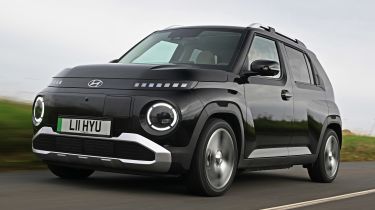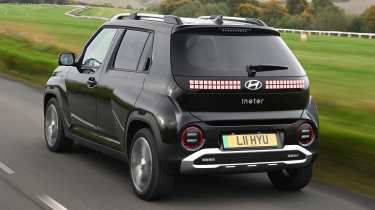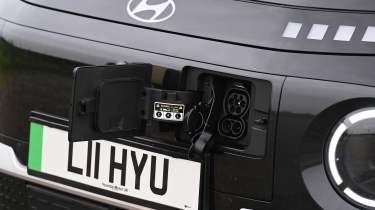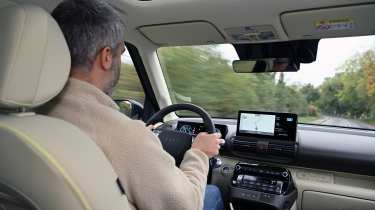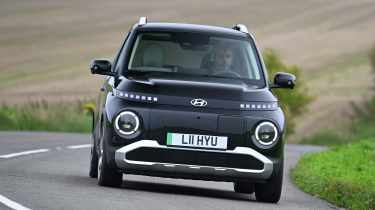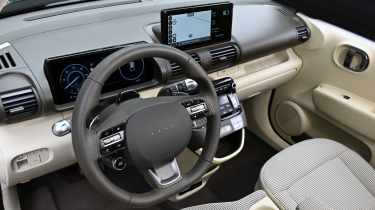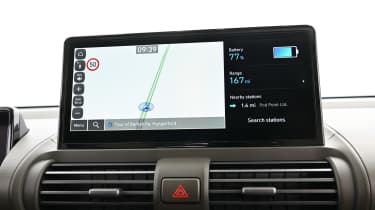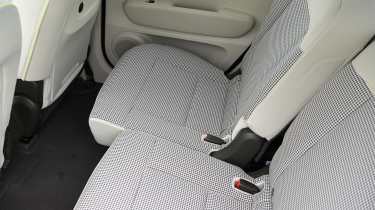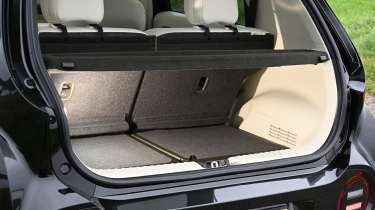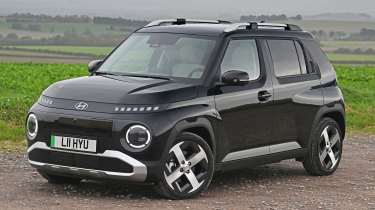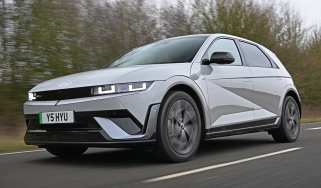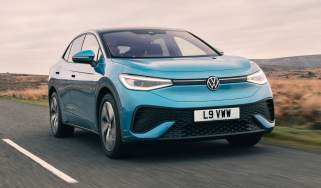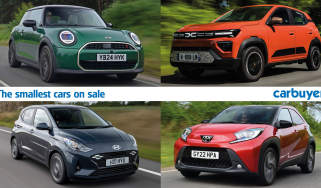Hyundai Inster review – the brand’s smallest, most affordable EV
“The Hyundai Inster looks pricey on the face of it, but it’s well built and upmarket inside”
Pros
- Good build and material quality
- Respectable range
- Roomy cabin
Cons
- Uncomfortable ride at low speeds
- Sliding rear seats only on more expensive models
- Expensive
Verdict – is the Hyundai Inster a good car?
The Hyundai Inster might seem a bit pricey for what is a small electric car, but dig a little deeper and it feels worth it. The interior is much nicer than that of a Citroen e-C3, it offers a respectable range from its battery, comes well equipped and feels good to drive. It’s not the most comfortable in the class, and the MINI Cooper offers more driving feel, but the Inster takes a different approach compared to retro-inspired rivals and is definitely worth your consideration.
Hyundai Inster models, specs and alternatives
The Hyundai Inster is the brand’s smallest and most affordable electric car, sitting below the Kona Electric in its lineup. The small and city car markets have been on the decline in recent years, with manufacturers finding it increasingly difficult to offer them at enticing prices while still making a healthy profit, but a slew of new small electric cars such as the Hyundai Inster promises to reinvigorate the sector.
The Inster has already existed in its home South Korean market with petrol and electric power under the name ‘Casper’, but comes to Europe with the new name and electric propulsion only.
Costing from £23,495, it takes on a new generation of small EVs such as the long-anticipated retro-inspired Renault 5, the MINI Cooper and slightly more upright upcoming models like the Renault 4 and Fiat Panda EVs. That price does seem quite a lot for a car of this size, but the focus here is on value for money, rather than out-and-out rock-bottom prices.
The Inster is available with a choice of two batteries, dubbed the Standard Range and Long Range. The smaller battery is a 42kWh unit and offered with a 96bhp electric motor, while the larger is 49kWh paired with a punchier 113bhp motor.
Two trim levels are offered, known simply as 01 and 02, and there will also be a standalone Inster Cross with a more SUV-styled exterior package arriving later. The 01 gets features like a digital gauge cluster, 10.25-inch infotainment screen with sat nav, climate control, adaptive cruise control and 15-inch wheels as standard. All cars also get a heat pump, which means the battery can be kept at optimal temperatures in colder weather, helping to preserve range. The Inster 02 starts from over £3,000 more but gets 17-inch alloys, privacy glass, heated seats and other niceties.
|
Trim levels |
Power options |
|
|
Range, charging & running costs
The Hyundai Inster is fully electric, and that means it should be more affordable to run in terms of tax thanks to zero tailpipe CO2 emissions. If you have a home wallbox to charge the Inster you could also save lots of money on charging it up, too.
The Inster’s range figures are good, if not amazing, but considering the small sizes of its batteries, it’s not bad at all. Hyundai says you can expect up to 229 miles from a charge of the 49kWh battery, while the smaller entry-level 42kWh battery can deliver up to 203 miles.
|
Model |
Battery size |
Range |
|
Hyundai Inster Standard range |
42kWh |
203 miles |
|
Hyundai Inster Long range |
49kWh |
229 miles |
How efficient is the Hyundai Inster in the real world?
Admittedly, during our time with the Hyundai Inster Long range, we only averaged around 3.8 miles per kWh, equalling around 186 miles on a charge, but we drove it hard on rural roads and motorways which weren’t necessarily comparable to average day-to-day driving habits. We think you could reasonably expect a range of around 200 miles from this model.
Electric motor, drive & performance
The Hyundai Inster may be new to the UK market, but it’s an all-electric version of a model already available in the South Korean market, where it’s called the Casper. Over there it gets petrol engines, but there’s no such option on the UK Inster.
While the Inster may be a small car, it’s got the refinement and composure of a much larger vehicle. The electric motor feels punchy and smooth, but the Inster is let down slightly by a harsh ride in some scenarios, which is made worse by its short wheelbase, which means it jumps around a bit at more moderate speeds.
The upside to this short wheelbase, however, is that the Inster does feel agile and handles very well – it would even give the MINI Cooper a run for its money in that sense, though the Cooper offers much more feel through the steering.
Is the Hyundai Inster good to drive in town?
Thanks to its small size, the Inster feels great to drive around town, although the ride could be better. It’s somewhat helped by sticking to the smaller 15-inch wheels, so we recommend getting a model with those fitted rather than the 17-inchers if you’ll mostly be doing shorter trips around town.
Is the Hyundai Inster good to drive on long journeys?
The Hyundai Inster feels very refined at speed for a car of its type. At a faster pace it’s more comfortable and does a better job at smoothing out imperfections, while also feeling well planted and composed. The instant shove from the electric motor is useful at speed, too, so overtaking should be easy.
Is the Hyundai Inster good to drive on B-roads?
The Hyundai Inster is nippy and good at changing direction quickly thanks to its short wheelbase, which should translate to a nimble drive on B-roads. The weight is all kept low down, and overall the Inster isn’t a heavy car, which works in its favour in these environments. One area where it falls behind some rivals, such as the MINI Cooper, is in steering feel – the Inster can feel a bit numb from behind the wheel.
|
Model |
Power |
0-62mph |
Top speed |
|
Hyundai Inster Standard range |
96bhp |
11.7 seconds |
87mph |
|
Hyundai Inster Long range |
113bhp |
10.6 seconds |
93mph |
Carbuyer notes
“On the road, the Hyundai has a large-car feel, in that it’s quiet, composed and even relatively punchy given the comparatively small electric motor.” Richard Ingram, Deputy Editor.
Interior & comfort
While the Hyundai Inster may not be the cheapest EV of its class on sale, one area where it feels good value is on the inside, where build and material quality feel top notch. Close the doors and they make a nice solid ‘thunk’ sound and the cabin feels rather upmarket.
Is the Hyundai Inster’s infotainment and navigation system easy to use?
The Hyundai Inster gets a 10.25-inch infotainment screen and a driver’s display of the same size. Smartphone integration comes as standard, so you can use Apple CarPlay and Android Auto, should you wish.
Is the Hyundai Inster well equipped?
There are just two trim levels for the Hyundai Inster: 01 and 02. Our test car was the 02 version, which felt particularly well equipped with heated front seats and steering wheel, front and rear parking sensors and privacy glass, as well as more stylish 17-inch wheels and roof bars. If you can do without those things though, the 01 specification is still pretty well loaded – the 15-inch wheels aren’t quite so good-looking, but you still get rear parking sensors, adaptive cruise control, the 10.25-inch infotainment screen and driver’s display, plus driver aids such as lane keep assist and collision avoidance tech, plus the all-important heat pump which should help preserve range.
Hyundai will be adding another trim level called ‘Cross’ – full details are yet to be released, but you can expect this version to lean further into the Inster’s SUV-inspired design, plus features like a panoramic sunroof for extra airiness.
Key features | |
|
01
|
02 (01 plus…)
|
Boot space, practicality & dimensions
The Hyundai Inster is a little and tall car designed for tight spaces, and yet practicality is impressive all things considered. Every seat offers good head and leg room even for taller adults, helped by the completely flat floor in the back. 02 cars even gain the ability to slide the rear bench back further for added legroom, or forward for extra boot space.
There’s not too much in the way of storage about the cabin itself, but it’s on par with most rivals at this price.
|
Size comparison | |||
|
Model |
Length |
Width |
Height |
|
Hyundai Inster |
3,825mm |
1,610mm |
1,610mm |
|
Renault 5 |
3,920mm |
1,770mm |
1,500mm |
|
Citroen e-C3 |
4,015mm |
1,755mm |
1,577mm |
|
MINI Cooper E |
3,858mm |
1,756mm |
1,460mm |
Does the Hyundai Inster have a big boot?
The Inster’s boot is fairly small, but as we mentioned before, it’s possible to slide the rear bench forward or backwards to prioritise either luggage or passenger space. When the seats are all the way back, there’s not much space at all, but push them forward and you can fit in larger bags or shopping – a clever partition also stops any items from falling into hard-to-reach crevices. Fold down the seats and you free up 1,059 litres of boot space.
|
Boot space comparison | |
|
Model |
Boot space |
|
Hyundai Inster |
238-351 litres |
|
Renault 5 |
326 litres |
|
Citroen e-C3 |
310 litres |
|
MINI Cooper E |
210 litres |
Reliability & safety
Hyundai is a regular high performer in our Driver Power customer satisfaction surveys, although it’s slipped slightly in 2024 to 17th place. Buyers love the brand’s infotainment, low running costs and value for money, but Hyundai falls behind in terms of styling, fit and finish and cabin design in the eyes of customers, but we think these last two aspects are much improved on the brand’s very latest cars.
Reliability was slightly better than average, even if it wasn’t anything to write home about – 22.8% of Hyundai owners reported an issue with their car in the first year of ownership. However, Hyundai vouches for its own reliability and offers to cover its cars for up to five years with no mileage cap, should anything go wrong through no fault of your own.
How safe is the Hyundai Inster?
The Hyundai Inster is yet to be crash tested by Euro NCAP, but it does come with a generous amount of driver assistance tech for a car of its size as standard. This includes adaptive cruise control, lane keep assist, collision avoidance tech and intelligent speed limit assist, among other features.
What is the warranty on the Hyundai Inster?
The Hyundai Inster gets the brand’s five-year unlimited-mile warranty. Alongside Kia’s seven-year/100,000-mile warranty, Hyundai’s has long been one of the best in the industry, but now other manufacturers are starting to step up. Toyota now offers a 10-year/100,000-mile warranty so long as you keep your Toyota serviced every year via a main dealer, while Dacia has recently upped its warranty to up to seven years or 75,000 miles, whichever comes first – again, so long as it’s serviced annually via a main dealer.
Should you buy a Hyundai Inster?
It may not be the cheapest EV on sale, but we think the Inster hits a sweet spot with price and value for money, because it certainly feels more upmarket than the cheaper Citroen e-C3. What it lacks in retro charm against cars like the Renault 5, it makes up for in quality, equipment and efficiency.
The Inster is quite nippy considering its low power figure, and feels very capable even on the twistiest roads. We think it’s just as agile as a MINI Cooper, though it doesn’t quite trump that car for driving feel.
The Inster is a small car, so don’t expect groundbreaking practicality, but interior space for four adults is impressive, and 02 cars get a useful sliding rear bench to prioritise luggage or passenger space, which improves things.
What is the Carbuyer pick of the Hyundai Inster range?
We think the 01 version of the Hyundai Inster is well equipped enough for most buyers, but if you need the flexibility of the sliding rear seats, then you’ll need to go for 02 spec.
Hyundai Inster alternatives
The Hyundai Inster goes up against a raft of new small affordable electric cars that are starting to hit the market. Renault, MINI and Fiat offer lots of charm with retro appeal, but Hyundai takes a different approach with rugged, SUV-like looks.
How we tested the Hyundai Inster
We tested a left-hand drive version of the Hyundai Inster on UK roads in October 2024.
Which Is Best?
Cheapest
- Name71kW 01 42kWh 5dr Auto
- Gearbox typeAuto
- RRP£23,495
Most Economical
- Name85kW 01 49kWh 5dr Auto
- Gearbox typeAuto
- RRP£25,045
Fastest
- Name85kW 01 49kWh 5dr Auto
- Gearbox typeAuto
- RRP£25,045
